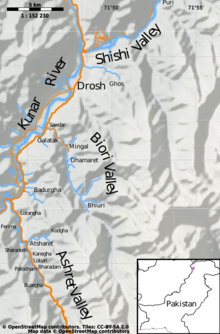
Back پالوله دیلی AZB Paloureg Breton زبان پالوله Persian Phaluran kieli Finnish Phalura French पालूला भाषा Hindi Lingua phalura Italian パルーラ語 Japanese Palula Occitan Lenga phalura PMS
| Palula | |
|---|---|
| پالُولا Paaluulaá | |
 Palula in Nastaliq | |
| Pronunciation | /paːluːlǎː/ |
| Native to | Pakistan |
| Region | Chitral |
| Ethnicity | Palula |
Native speakers | 10,000 (2018)[1] The population of Ashret and Biol Valleys is almost completely monolingual (2008)[1] |
| Palula alphabet (Nastaʿlīq script) | |
| Language codes | |
| ISO 639-3 | phl |
| Glottolog | phal1254 |
| ELP | Phalura |

Palula (also spelt Phalura, Palola, Phalulo) and also known as Ashreti (Aćharêtâʹ) or Dangarikwar (the name used by Khowar speakers), is an Indo-Aryan language spoken by approximately 10,000 people in the valleys of Ashret and Biori, as well as in the village of Puri (also Purigal) in the Shishi valley and at least by a portion of the population in the village Kalkatak, in the Chitral District of Khyber Pakhtunkhwa province of Pakistan.[3]
In some of the smaller villages, Palula has either ceased to be spoken (in the village Ghos, situated near Drosh) or its speakers are largely shifting (as in Puri and Kalkatak) to the more widely spoken Khowar language. However, in the main Palula settlements in the Biori and Ashret valleys, it is a strong, vibrant and growing language, as the population in those areas increases and it is still with a few exceptions the mother tongue of almost all people.
Palula is pronounced as /paːluːlǎː/, with three long vowels and a rising pitch on the final syllable.
- ^ a b Palula at Ethnologue (25th ed., 2022)

- ^ a b Hammarström, Harald; Forkel, Robert; Haspelmath, Martin; Bank, Sebastian (2023-07-10). "Glottolog 4.8 - Dangari". Glottolog. Leipzig: Max Planck Institute for Evolutionary Anthropology. doi:10.5281/zenodo.7398962. Archived from the original on 2023-11-06. Retrieved 2023-11-05.
- ^ Bergqvist, Henrik; Kittilä, Seppo. Evidentiality, egophoricity and engagement. Language Science Press. p. 142. ISBN 978-3-96110-269-3.
© MMXXIII Rich X Search. We shall prevail. All rights reserved. Rich X Search